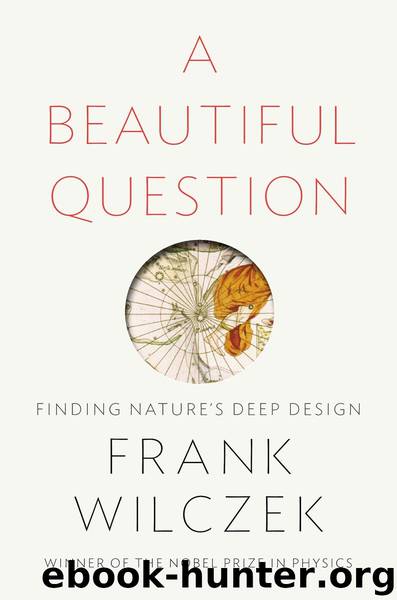A Beautiful Question: Finding Nature's Deep Design by Frank Wilczek

Author:Frank Wilczek
Language: eng
Format: mobi
Publisher: Penguin Publishing Group
Published: 2015-07-13T14:00:00+00:00
PART 4: SUMMING UP
The Census of Forces and Entities
We have four fundamental forces: gravity, electromagnetism, and the strong and weak forces. All are described, theoretically, using local symmetry. The theory of gravity, Einstein’s general relativity, is based on local symmetry of space-time, while the theories of the other three forces are based on local symmetry of property spaces.
General relativity is a rich theory, and far from easy to master. But it is based on the interplay between ordinary space-time and energy-momentum, which are universal concepts that don’t require a detailed census. We mean no disrespect, therefore, when we acknowledge this interplay in the single word “gravity.”
Because the behavior of matter, with respect to the other three forces, is determined by flows in property spaces, we need to describe the geometry of the property spaces it inhabits in order to give an account of matter. I will do that in two stages, represented in plates RR and SS and in plates TT and UU. In the first stage I’ve passed over some complications that I’ve added back in the second stage.
In plates RR and SS, you see that there are six distinct blocks. Inside the blocks are names of particles: u and d quarks in three colors (red, green, and blue u quarks, for example), and e and ν leptons (electron and neutrino). Each block encodes, in a way we’ll presently describe, a possible property space for matter. So these six blocks represent six distinct varieties of matter that occupy different kinds of property spaces. Some of the blocks contain several distinct kinds of particles; the largest one (block A) has six. From our—and, more to the point, the forces’—perspective, the different particles within a block are really a single entity, seen at different positions in the property space. Our census contains sixteen distinct kinds of particles—a disturbingly large number of fundamental world-ingredients! From our deeper perspective we see that those sixteen particles represent only six distinct entities—significantly fewer (but still too many . . . we’ll do better in the next chapter).
In the horizontal direction, we represent the three dimensions of strong charge (or “color”) space. The blocks that have three columns (A, B, and C) represent entities that can move in a three-dimensional strong charge property space. In the vertical direction, we have the dimensions of weak charge space. The blocks that have two rows (A, D) represent entities that can move in a two-dimensional weak charge property space. The entity represented by block A can move independently in both ways, so it samples 3 × 2 = 6 property dimensions.
The numbers attached to each block represent the scale of its one-dimensional electric charge property space.*
Finally, the superscripts L and R denote, respectively, left-handed and right-handed. Lee and Yang taught us that only the left-handed quarks and leptons participate in the weak force. In our census, this is encoded in the fact that only the blocks with L superscript contain two rows. Each particle occurs in both its left-handed and right-handed forms, within different blocks.
Download
This site does not store any files on its server. We only index and link to content provided by other sites. Please contact the content providers to delete copyright contents if any and email us, we'll remove relevant links or contents immediately.
The Complete Stick Figure Physics Tutorials by Allen Sarah(7307)
Secrets of Antigravity Propulsion: Tesla, UFOs, and Classified Aerospace Technology by Ph.D. Paul A. Laviolette(5309)
Thing Explainer by Randall Munroe(3877)
The River of Consciousness by Oliver Sacks(3540)
The Order of Time by Carlo Rovelli(3145)
How To by Randall Munroe(3035)
A Brief History of Time by Stephen Hawking(2961)
I Live in the Future & Here's How It Works by Nick Bilton(2935)
The Great Unknown by Marcus du Sautoy(2648)
What If?: Serious Scientific Answers to Absurd Hypothetical Questions by Randall Munroe(2637)
Midnight in Chernobyl by Adam Higginbotham(2483)
Blockchain: Ultimate Step By Step Guide To Understanding Blockchain Technology, Bitcoin Creation, and the future of Money (Novice to Expert) by Keizer Söze(2446)
Networks: An Introduction by Newman Mark(2360)
The Meaning of it All by Richard Feynman(2300)
Easy Electronics by Charles Platt(2281)
The Tao of Physics by Fritjof Capra(2231)
Midnight in Chernobyl: The Untold Story of the World's Greatest Nuclear Disaster by Adam Higginbotham(2177)
When by Daniel H Pink(2083)
Introducing Relativity by Bruce Bassett(2078)
